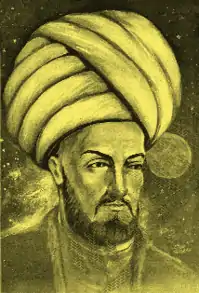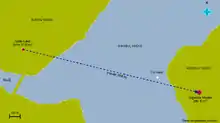Hezârfen Ahmed Çelebi
Hezârfen Ahmed Çelebi (Ottoman Turkish: هزارفنّ أحمد چلبی,, lit. 'Polymath Ahmed the wise'[1][2]) was an Ottoman scientist from Istanbul reported in the writings of traveler Evliya Çelebi to have achieved sustained unpowered flight.[3] While modern historians disagree with Evliya Çelebi's narration of Hezarfen flying the entire Bosporus,[4] they state that the flight most likely was real, but heavily exaggerated, as Çelebi often exaggerates in his writings.[5][6] He has great reputation in Turkey as an inspiration for future generations of aviators.
Hezârfen Ahmed Çelebi | |
|---|---|
 | |
| Born | Ahmed 1609 Constantinople, Ottoman Empire |
| Died | 1640 (aged 30–31) Algeria |
| Nationality | Ottoman |
| Occupation | Scientist |
| Known for | Unpowered flight |
Non-powered flight
The 17th century writings of Evliyâ Çelebi relate this story of Hezârfen Ahmed Çelebi, circa 1630–1632:
First, he practiced by flying over the pulpit of Okmeydanı eight or nine times with eagle wings, using the force of the wind. Then, as Sultan Murad Khan (Murad IV) was watching from the Sinan Pasha mansion at Sarayburnu, he flew from the very top of the Galata Tower (in contemporary Karaköy) and landed in the Doğancılar Square in Üsküdar, with the help of the south-west wind. Then Murad Khan granted him a sack of golden coins, and said: "This is a scary man. He is capable of doing anything he wishes. It is not right to keep such people," and thus sent him to Algeria on exile. He died there.
— Evliyâ Çelebi, [3]
While modern historians disagree with Evliya Çelebi's narration of Hezarfen flying the entire Bosporus,[4] they state that the flight most likely was real, but heavily exaggerated, as Çelebi often exaggerates in his writings.[5][6]

The title "Hezârfen", given by Evliyâ Çelebi to Ahmet Çelebi, is from Persian هزار hezār + فنّ fann meaning "having a thousand sciences" (polymath).[1]
Historic account
In 1648, John Wilkins cites Ogier Ghiselin de Busbecq, the Holy Roman ambassador to Constantinople in 1554–1562, as recording that "a Turk in Constantinople" attempted to fly.[7] However, if accurate, this citation refers to an event nearly a century prior to the exploits reported by Evliyâ Çelebi.
Evliyâ Çelebi's account of the exploits of Hezârfen Ahmet Çelebi is three sentences long (of a ten volume work). The story has great currency in Turkey as he is an inspiration for future generations of aviators.
Modern era
- One of 4 airports in Istanbul is named the "Hezarfen Airfield".
- A mosque next to the Istanbul Atatürk Airport bears the appellation "Hezarfen Ahmet Çelebi".
- A 1996 feature-length film, "Istanbul Beneath My Wings" (İstanbul Kanatlarımın Altında) concerns the lives of Hezârfen Ahmet Çelebi, his brother and rocket aviator Lagari Hasan Çelebi, and Ottoman society in the early 17th century, as witnessed and narrated by Evliyâ Çelebi.
References
- hezarfen Archived 20 October 2013 at the Wayback Machine TDK Büyük Türkçe Sözlük. Erişim: 26 Mayıs 2009
- "çelebi". Nişanyan Sözlük (in Turkish). Archived from the original on 9 November 2019. Retrieved 9 November 2019.
- Çelebi, Evliya (2003). Seyahatname. Istanbul: Yapı Kredi Kültür Sanat Yayıncılık, p. 318.
- Yalçın, Tuncer (2018-10-26). "Hezarfen Ahmet Çelebi Kimdir? Gerçekten Uçtu Mu?". Ders: Tarih (in Turkish). Retrieved 2020-11-26.
- Özay, Yeliz. "EVLİYÂ ÇELEBİ SEYAHATNÂMESİ'NİN ACÂİB EDEBİYATI AÇISINDAN DEĞERLENDİRİLMESİ" (in Turkish).
- HIZLAN, Doğan. "Postmodern bir romancı: Evliya Çelebi". www.hurriyet.com.tr (in Turkish). Retrieved 2020-11-26.
- Wilkins, John. Mathematicall Magick or the Wonders that may be performed by Mechanicall Geometry. In two books. Concerning Mechanicall Powers and Motions, London 1648, 204; also see a reprint of the same book in The Mathematical and Philosophical Works of John Wilkins to which is prefixed the author's life and an account of his works, 1802, vol. II, 201